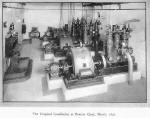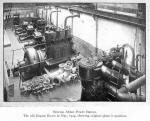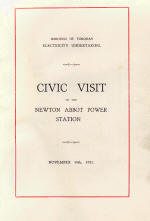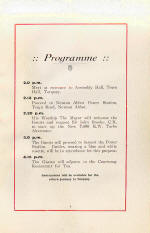| |
The information recorded below has been extracted
from a document held at the Newton Abbot Museum to whom I am extremely
grateful for their help and assistance. The document was published by the
Borough of Torquay Electricity Undertaking and notes the official opening
of Newton Abbot Power Station Extensions on 1st May 1929. |
| |
|
| |
The document covers the period 1898 and plans
beyond 1929. |
| |
|
| 1898
Torquay |
First supplies to Torquay were introduced in March
1898. The generating plant was placed in buildings that formed Beacon Quay
on Torquay Harbour. The first generators were three reciprocating steam
engine generator sets - probably 50 kw each with a combined capacity of 150 kw.
They were Alternating Current (AC) 2000 volt single
phase machines operating at 50 cycles. These were manufactured by Willans.
(A notable name in heat engine theory!) |
| |
|
| |
|
The boiler plant by Babcock and Wilcox operated at
150 psi and 500 deg F was placed within the cellar areas of the Beacon
Quay buildings. As the demand increased any space was taken up with
additional generating capacity ultimately reaching the limit of the boiler
capacity that could be installed. Thus around 1920 the Borough Engineer
concluded that a new site was needed and finally settled on the area
currently being operated by the Urban Electric Supply Co. Ltd. at Newton
Abbot. At this stage Beacon Quay was equipped with a 500 kw
generating set and
two 1250 kw BTH turbo alternators - a capacity of 3000 kw. The maximum boiler
capacity was however 1500 kw limiting output somewhat. There was clearly a
continuous up rating of plant throughout this period. |
 |
| |
|
| 1924
Torquay |
The demand in Torquay was mainly
lighting and tramway systems. The Tramway was most probably DC but no
reference is made to convertors in the document. Beacon Quay was shut down on 24th July 1924
(site demolished in 1961)
when AC supplies became available from Newton Abbot. It is interesting to
note that prior to 1923 supply cables lay in the gutters! The initial
connection from Newton Abbot to Torquay (Upton Vale) was established in
1924 being two 11000 Volt circuits with a number of step down
transformers connected. An original building on the route stands beside
the A380 in the centre of the Kingskerswell village dated 1924. The 1250 kw generators were transferred to Newton
Abbot and were located where the three 40 kw DC generator sets were
originally located. Steam conditions were very similar. |
| |
|
| 1898
Newton Abbot |
Supplies to Newton Abbot were Direct Current (DC)
being mainly used for industrial loads. Based on the photograph below the
original plant was most probably three 40kw steam driven generator sets
giving a combined capacity of 120 kw. Later two 200 kw DC generators were added bringing the
capacity to 520 kw before 1920. The picture below shows the plant
installed in 1924. |
| |
|
| 1923 |
Through a series of Acts and consideration by the
Electricity Commissioners the ownership of the site at Newton Abbot
transferred from the Urban Electricity Supply Co. Ltd to the Urban
District of Newton Abbot and then onwards to the Borough of Torquay on 1st
May 1923. |
| |
|
| 1923 |
During the period 1920 to 1923 much
design work had
been completed by the Torquay Borough Engineer and contracts were in place
to commence work almost immediately on completion of the transfer to the
Borough of Torquay. Due to extensive flooding and bad weather
conditions work on the River side No 1 Pump House did not commence until May 1924. |
| |
|
| 1923/24 |
 |
Between May 1924 and July 1924
Generator 3 was brought on line supplying up to 3750 kw AC. The picture
(taken in 1924)
appears to show the first of the 200 kw generators in the process of
decommissioning. The generating set in the foreground ( Belliss and Morcom 200 kw
500 volt DC) remained in situ until the station decommissioned during the
1970's.
Rotary Convertor plant was commissioned to maintain DC supplies for Newton
Abbot and located where the decommissioning generator is located. By September 1924 the station capacity
was 6250 kw with generators Nos 1 and 2 having
been transferred from Beacon Quay, Torquay and connected to the new
'cellular' switch board via 2000/11000 volt transformers. They were
situated where the original three 40kw generators were located at the
distant end of the picture. |
| |
|
| 1926 |
During this period generator No 4 (3750 kw) was added and the
station capacity increased to 10,000 kw |
| |
|
| 1929 |
The first phase development of the
station continued with the addition of generator No 5 (7500 kw) with
boilers 9 and 10 taking the capacity
to 17,500 kw. It was at this point that 'Official Opening of Newton Abbot
Power Station Extensions' occured. The GenCap page shows the whole capacity sequence over
time. A second River side pump house was added to cater for the 'planned'
developments. |
| |
|
| 1931 |
 |
 |
In 1931 generator 6 (7500kw) was
commissioned with boilers 11 and 12 but to commission this generator a new
11 kv switchboard was required and to release space the original
generators 1 and 2 were decommissioned. The original switchgear being
unable to meet the fault ratings the 11 kv switch boards were connected by
10 MVA air cooled reactors and generator 5 moved to this switch board. A
Civic Visit occurred to mark the completion of this phase.
|
| |
|
| 1934 Grid
System arrival |
A single circuit interconnection rated
at 50 MW was established at 132,000 volts between Exeter, Newton Abbot,
Plymouth and Fraddon terminating at Hayle in Cornwall. This was the first
implementation of the now standardised power system providing
interconnection across South Wales to Reading and the South from Brighton
to the tip of Cornwall. System Operation was centered on Oakfield Grove in
Clifton, Bristol with an emergency control being located in the cellar of
a house in Keynsham - Durley Park. This became the Grid Control Centre in
1954 until its close in 1995. Operation of the National Grid with all
regions interconnected occurred unofficially in 1937 by an adventurous
group of night shift control engineers! |
| |
|
| 1941 |
Development continued with the build of
Generator 7 with boilers 13 and 14. At the same time a cooling tower was constructed to cope
with the cooling requirements of generator 7 and the future
turbo-alternator no 8. The cooling
tower serving Generators 7 required 'river water make up' whilst the MP and LP
generators
re-circulated all cooling water to the River. |
| |
|
| 1948 |
Saw the final commissioning of
Generator 8 and boilers 15 and 16. The station was now at what was to be
its final capacity of 48.5 MWSO (Mega Watts Sent Out) and an installed
capacity of 52.5 MWI. Whilst I have no information on the operation during
the winter of 1947 it is probable that it was similar to the 1962/3 winter |
| |
|
| 1959 |
The original low pressure boilers
constructed during 1924/26 were decommissioned and removed. This reduced the station overall
capacity by a small amount due to the length of the High/Low steam
pressure reducing range and resulting terminal steam conditions. Generators 3 and 4 each being re-rated
from 3750 kw to 3500 kw. The area occupied by these boilers was converted
into a self contained Civil Defence shelter not visible to the outside
world! |
| |
|
| 1962/1963 |
This period saw one of the most testing
periods for the station with the very severe winter before the Supergrid
(275 kv) System
was extended and before generating plant margins had been improved to
cover all eventualities. The station operated at its installed and maximum
capacity for extended periods and also at emergency levels for a number of
limited periods. Regular demand reduction and load disconnections occurred
to maintain the overall power supply system. For a number of periods the
output from the 52 MW of plant installed exceeded 62 MW whilst emergency
generation was instructed. Bearing in mind the age of the plant this was
some achievement. |
| |
|
| 1964 |
Nationally new generating plant started
coming on line rapidly and the requirement for the older inefficient plant
reduced to the 'winter peak' demand periods or demand security
considerations. The station spent
extended periods in 'cold shut down'. This marked the beginning of the end
although draft plans did exist to replace the station with 'modern' gas
turbine generation. This obviously never happened and the site was fully
closed and demolished in the mid 1970's. |
